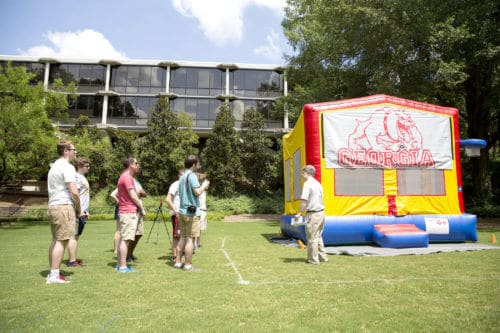Heat safety issues in bounce houses can put children in danger, says a new University of Georgia study.
Expanding on the concept of microclimates like those in parked vehicles that cause serious injuries to children, the study investigated potential heat-related risks associated with bounce houses, which create a microclimate environment similar to automobiles but one that had not been previously examined.
The new paper, “Do Inflatable Bounce Houses Pose Heat-related Hazards to Children,” was published July 28 in the early online edition of the Bulletin of the American Meteorological Society.
The study examined specific research questions that compared temperature and moisture conditions inside the bounce house to ambient outdoor conditions, and whether such differences might reach levels that pose health risks.
“Heat illnesses like heat stroke can be deadly and occur in children participating in sports, left alone in parked cars, and as our study shows, potentially when playing in bounce houses,” said Andrew Grundstein, UGA professor of geography and co-author on the study. “Children are more sensitive to heat than adults and parents need to carefully watch their children for signs of overheating when active on hot and humid days. Signs there is a problem may include fatigue, nausea, vomiting, dizziness, and flushed, moist skin.”
The findings are based on experiments with a bounce house on the UGA campus in July 2015, with weather conditions representative of a typical summer day in the area. Over a five-hour period of measurements, researchers found that air temperatures inside the bounce house were consistently greater than ambient conditions. For a 92-degree summer day in Athens, the bounce house added almost 4 degrees to the temperature. But peak bounce house temperatures exceeding 100 F were almost 7 degrees Fahrenheit more than outside temperatures.
“This research is a preliminary look at something that no one had really examined in the published literature,” said Marshall Shepherd, UGA Athletic Association Distinguished Professor of Geography and Atmospheric Sciences and co-author on the study. “I knew it was a problem when I watched my child in one on a particularly hot day and our early findings confirmed my suspicions. Hopefully it makes parents more aware of something they probably overlooked.”
Researchers also considered the heat index, which integrates air temperature and humidity and is used as a heat exposure metric by the National Weather Service. The difference in heat index within and outside the bounce house was larger than for air temperatures alone. The average heat index reached almost 104 F in the bounce house, over 7 degrees Fahrenheit more than outside, and its peak temperature of 117 F was over 8 degrees Fahrenheit greater.
As a guide to help public safety officials, the media and parents assess possible heat-related hazard to children, researchers developed a modified heat index table presented in Fahrenheit that is included in the study.
The experiments in July 2015 took place in conjunction with a demonstration on weather-related bounce accidents in a “Collaborative Research in Atmospheric Sciences” class. The seminar, “Meteorological and Policy Contexts of Bounce House Accidents,” involved students in the department of geography and is the focus of other forthcoming research by faculty on other significant hazards of bounce houses including wind blown risks and outflow from thunderstorms.
If our reporting has informed or inspired you, please consider making a donation. Every contribution, no matter the size, empowers us to continue delivering accurate, engaging, and trustworthy science and medical news. Independent journalism requires time, effort, and resources—your support ensures we can keep uncovering the stories that matter most to you.
Join us in making knowledge accessible and impactful. Thank you for standing with us!

